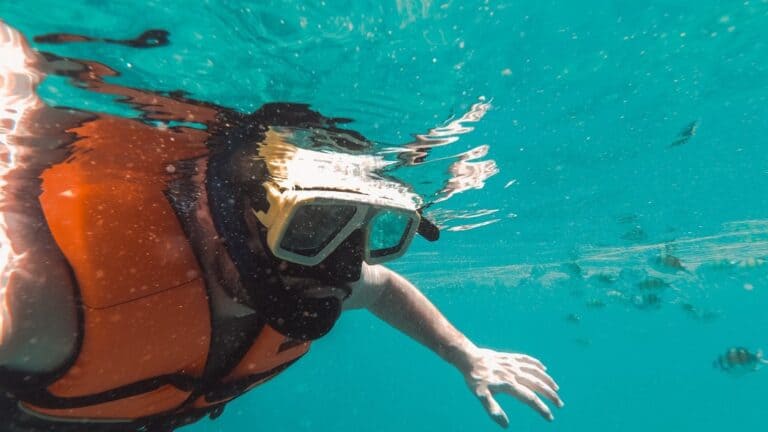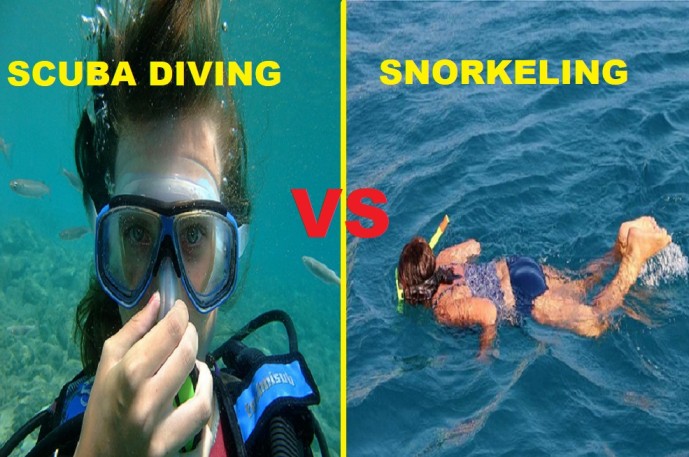Are Scuba And Snorkel Masks The Same?
Most of my friends started snorkeling before taking up scuba diving lessons. I’m no exception I loved snorkeling and viewing the different types of fish underwater but something inside me wanted to explore more of the underwater world. The most common question is can I use a snorkeling mask for scuba diving? Are they the same or do you need to invest in a new scuba diving mask?
Here’s what I know from owning both a scuba and snorkel mask.
Scuba and snorkel masks are not the same in terms of material used, build, fit, and price range. Scuba masks are built and designed to withstand high pressure while diving protecting the divers’ eyes and face while snorkel masks aren’t designed for high pressure since they are only used on the water’s surface.
To a complete beginner, the two masks may look very similar but upon closer inspection, the differences are easily noticed.
The main difference is in the ability to withstand high water pressure from the high-grade material used in building scuba masks. Other differences include price range, additional accessories on the mask, and strap types among others.
In this article, we’ll dive deeper into the differences, whether it’s possible to use one mask in place of the other, the dangers involved in interchanging masks and so much more.
Keep reading to learn more!
READ MORE: Why Do Divers Spit In Their Masks?
Differences between a Scuba and Snorkel Mask
| Scuba Mask | Snorkel Mask | |
| Material Used | Tempered glass
High-quality silicon | Polycarbonate Plastic
Rubber or low-quality silicon |
| Build | Withstands high pressure | Build for surface use. For low or no pressure |
| Design | Less buoyant
Designed to help divers stay in the water | Buoyant
Designed to keep you floating on the water’s surface |
| Price | $$ – $$$ (Can be quite expensive) | $ – $$ (very affordable) |
| Perfect fitting | Must fit perfectly | Doesn’t have to fit perfectly |
| Accessories | Can have accessories such as a camera holder | Doesn’t have accessories |
| Fogging | Low to no fogging | Quick fogging |

Design
Both scuba and snorkel masks come as full-face or half-face masks.
Scuba masks are designed to keep water out of the mask and only trap little air within the mask. In snorkel masks, on the other hand, some water can get into the mask without causing any major problems.
While both are designed to explore underwater, snorkel masks are designed to only explore from the surface of the water while scuba masks are designed to explore underwater.
Basic snorkel masks have a snorkel that extends above the water allowing you to breathe. It also helps keep your head leveled as you snorkel.
Snorkel masks have a wider view window compared to scuba masks.
Snorkel masks only allow you a bird’s view you can only see what floats or swims in the topmost water layer. With scuba masks, you can explore deep into the corals and caves.
Since the body floats on water while snorkeling, buoyancy isn’t a big issue in snorkel masks. Snorkel masks have however advanced over the ears and the technology used to design them today allows you to dive a few meters underwater and explore more.
Scuba masks, on the other hand, factor buoyancy in the design. The mask allows you to stay underwater without being pulled up during the dive.
Half scuba and snorkel masks look very similar since they both cover the eyes and the nose and tend to have very similar shapes.
Full-face scuba masks however stand out from full-face snorkel masks. These have a regulator attached making the mask look like something a scientist would wear when handling poisonous gases. It’s very difficult to confuse a full-face scuba mask for a full-face snorkel mask.
Build

Scuba diving involves going over 20 meters underwater, deep divers can go over 80 meters or more. In such extreme conditions, the pressure is high, there are other objects floating around and the water gets very cold.
The Scuba mask is built and tested to withstand these extreme environments by using high-quality materials. The materials also need to be strong enough to keep the divers protected.
Snorkel masks are only used on the water surface and maybe for shallow divers. At these levels, the water pressure isn’t high to shatter the masks.
In addition, in case a snorkeler experiences some kind of discomfort or malfunction with their mask all you have to do is lift your head on the water surface and fix or change it.
Divers on the other hand don’t have the luxury of changing their masks when diving. In case of a malfunction, the diver has to still ascend slowly to prevent an injury such as the bends or pulmonary embolism.
For this reason, scuba diving masks have to meet high design and building standards to keep divers safe.
Materials Used
To withstand high pressure and other extreme conditions, scuba masks are built using high-quality materials. Everything from the lenses, straps, the skirt, and the frames has to be strong enough.
Scuba masks use tempered glass and high-quality silicon which is more durable and soft. This allows the skirt to tightly seal onto the diver’s face preventing any water from getting into the mask. The soft silicon also keeps the divers’ skin protected without causing any unnecessary pressure or damage.
Tempered glass not only reduces fogging in the mask, but also keeps divers protected in case of accidents. Compared to normal glass, tempered glass doesn’t shatter into tiny pieces under high pressure. The glass can break but it won’t crumble or fall off the mask frame in a thousand tiny pieces that will easily injure the eyes and the face.
Most snorkel masks use rubber and plastic for the lenses. Plastic will easily break under high pressure and can injure the diver. These materials are best fit for shallow dives only and perform best in such conditions.
Snorkel masks are designed for the safety of a snorkel and should only be used for the right purpose.
Perfect Fitting
Soft silicone used in scuba masks ensures the mask fits perfectly; the silicon softly seals the mask onto your face preventing air or water from getting into the mask.
When picking a scuba mask always test it without attaching the straps to the back of your head. If you can breathe easily and the mask stays in place then it’s the perfect fit for you. However, if the mask feels loose or you can feel cold air getting in then this isn’t your fit.
Snorkel masks, on the other hand, don’t have to fit perfectly, you can easily snorkel with one that fits well not perfectly.

Price Range
Scuba masks are more expensive compared to snorkel masks. Depending on your preference, dive purpose, accessories on the mask, and brand scuba masks go for as low as $25 to over $900.
For recreational diving masks ranging up to $200 will work just perfectly. Full-face scuba masks can also be used for recreational diving but these will set you back about $300 and above.
It’s important to do your research first before investing in a full-face mask. After all, this is a lot of money you are putting into it.
Snorkel masks are very affordable ranging from $15 to $90. You can invest in a snorkel mask or simply rent one whenever you go snorkeling.
Can I Use A Scuba Mask For Snorkeling?
Yes, you can use a scuba mask for snorkeling.
A half-face scuba mask works just fine for snorkeling but you will require a snorkel that extends from your mouth to the water’s surface.
Full-face scuba masks however may not be the best option if you want to go snorkeling. These can be quite heavy and uncomfortable for snorkeling.
Scuba masks are designed and built to withstand high pressure meaning they will work just fine on the water surface.
READ MORE: Best Scuba Diving Masks for Small Faces
Can A Snorkel Mask Be Used For Scuba?
No, snorkel masks should never be used for scuba diving.
First, the mask isn’t designed to withstand high pressure and extreme conditions experienced in scuba diving.
Secondly, the materials used can’t perform well under high pressure. The plastic or acrylics used for the view window will shatter under high pressure and is likely to injure your eyes and face.
The rubber or low-grade silicon used for the skirt can allow water to flow into the mask or it can easily slip or come off.
In addition, the snorkel on the snorkel mask can only function a few inches underwater before it is submerged. Plus the design of the snorkel mask is meant to keep your head on the water’s surface so it will pull you up when you try to dive.
It’s quite dangerous trying to scuba dive in a snorkel mask.
Similarities in Scuba and Snorkel Masks
- Basic scuba and snorkel masks only cover the eyes and the nose
- They are both designed to help you view the underwater world. (At different depths)
- Available in half-face and full-face masks
Final thoughts
Scuba and snorkel masks are definitely not the same. Differences are evident in the materials used, the design and general assembly of the masks as well as the price range.
You can only use a scuba mask for snorkeling but never use a snorkel mask for scuba diving due to the high risks discussed in this article.
If you participate in both activities quite often it would be better to get a scuba mask and a snorkel to use for both activities, or simply rent out the gear when you go diving or snorkeling.
I hope this article provided the answers you had on “are scuba and snorkel masks the same”.



